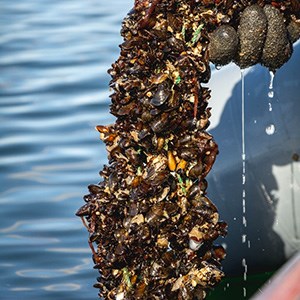Facts:
Project period 160301-190331. The project was funded by the European Regional Development Fund. The total budget was 3,6 million Euro that corresponds to about 35 million SEK.

Baltic Blue Growth was an Interreg project that aimed to tackle Baltic Sea eutrophication through establishing operational mussel farms and securing viable solutions for the produced mussels.
Six farms in different parts of the Baltic Sea (see map) form the basis for the Baltic Blue Growth project. The farms have been selected with the aim of covering different environmental conditions (locations both in the open sea and the archipelago) and different cultivation techniques (both long-line and net systems will be used).
Cultivating and harvesting blue mussels in the Baltic Sea can substantially improve the water quality as mussels take up nutrients through their food intake. At the same time, it can contribute to blue growth by providing new business models for the feed industry, which can use mussel meal as an ingredient in animal feed, replacing e.g. imported fish and soybean meal. Mussel farming in the Baltic Sea has so far not gone beyond experimental scale. To build up a commercially viable mussel farming value chain, it is not only necessary to develop suitable farming techniques for Baltic Sea conditions, but also to develop accepted mechanisms to compensate the ecosystem services provided by mussel farming.
Our aim is to advance mussel farming in the Baltic Sea from experimental to full scale. More specifically, we want to achieve
• the recognition of blue mussels as an efficient way of counteracting eutrophication, complementing legally required source related measures
• acceptance of a compensation scheme for the ecosystem service
provided by the mussels
• the establishment of mussel farming as an attractive market for entrepreneurs
• the production of mussel meal as an ingredient in animal feed
To pave the way for full-scale mussel farming, the project partners will clarify environmental, legal and regulatory aspects of mussel farming. Based on data and experiences collected at the fully operational mussel farms to be established by Baltic Blue Growth, the project’s main outputs will include:
• Models and functional decision support tools on suitable farming sites and their production potential
• Business plans and farming manuals for large scale mussel farms
• A demonstration line for processing mussels into fish and poultry feed
• A guide on licensing processes for mussel farming in the Baltic Sea Region
• Recommendations on harmonized maritime spatial planning and ecosystem service compensation measures
The role of SLU is to effectively explore the potential for use of mussels as feed to fish and poultry through testing the nutritive value and feed safety aspects of farmed mussels. The communication is recognized as a key factor for the project success and SLU provides information flow and technical support to project partners engaged in other project activities.
Region Östergotland is the lead project partner.
Processing and storage of mussels: mussels to feed through fly larvae
Food and feed safety aspects of mussel- and insect-based feed
Project period 160301-190331. The project was funded by the European Regional Development Fund. The total budget was 3,6 million Euro that corresponds to about 35 million SEK.